
Cloyne is a small town to the southeast of Midleton in eastern County Cork. It is also a see city of the Anglican Diocese of Cork, Cloyne and Ross, while also giving its name to a Roman Catholic diocese. St Colman's Cathedral in Cloyne is a cathedral church of the Church of Ireland while the Pro Cathedral of the Roman Catholic Diocese of Cloyne, Cobh Cathedral of Saint Colman, overlooks Cork Harbour. Cloyne is within the Cork East Dáil constituency.

Killiney is an affluent suburb in the southern coastal part of County Dublin, Ireland. It lies south of Dalkey, east and northeast of Ballybrack and Sallynoggin and north of Shankill. The place grew around the 11th century Killiney Church, and became a popular seaside resort in the 19th century. The area is notable for some famous residents, including two members of U2, and Enya.

Kilmacduagh Monastery is a ruined abbey near the town of Gort in County Galway, Ireland. It was the birthplace of the Diocese of Kilmacduagh. It was reportedly founded by Saint Colman, son of Duagh in the 7th century, on land given him by his cousin King Guaire Aidne mac Colmáin of Connacht.
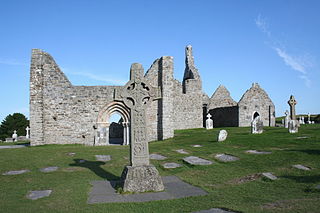
Clonmacnoise is a ruined monastery situated in County Offaly in Ireland on the River Shannon south of Athlone, founded in 544 by Saint Ciarán, a young man from Rathcroghan, County Roscommon. Until the 9th century it had close associations with the kings of Connacht.

Lorcán Ua Tuathail, known in English as Laurence O'Toole and in French as Laurent d'Eu, was Archbishop of Dublin at the time of the Norman invasion of Ireland. Lorcán played a prominent role in the Irish Church Reform Movement of the 12th century and mediated between the parties during and after the invasion. He was canonised in 1225 by Pope Honorius III.

O'Flaherty is an Irish Gaelic clan based most prominently in what is today County Galway. The clan name originated in the 10th century as a derivative of its founder Flaithbheartach mac Eimhin. They descend in the paternal line from the Connachta's Uí Briúin Seóla. They were originally kings of Maigh Seóla and Muintir Murchada and as members of the Uí Briúin were kinsmen of the Ó Conchubhair and Mac Diarmada amongst others. After their king Cathal mac Tigernán lost out to Áed in Gai Bernaig in the 11th century, the family were pushed further west to Iar Connacht, a territory associated with Connemara today. They continued to rule this land until the 16th century. The name has been alternatively rendered into English in various forms, such as Flaherty, Fluharty, Faherty, Laverty, Flaverty, Lahiff, and Flahive.

The Cathedral Church of St Colman, usually known as Cobh Cathedral, or previously Queenstown Cathedral, is a single-spire cathedral in Cobh, Ireland. It is a Roman Catholic cathedral and was completed in 1919. Built on Cathedral Place, it overlooks Cork harbour from a prominent position, and is dedicated to Colmán of Cloyne, patron saint of the Diocese of Cloyne. It serves as the cathedral church of the diocese.

Colmán of Cloyne, also Colmán mac Léníne, was a monk, founder and patron of Cluain Uama, now Cloyne, County Cork, Ireland, and one of the earliest known Irish poets to write in the vernacular.

Rathmichael is a suburb south-east of Dublin, in the local government area of Dún Laoghaire–Rathdown, near the southern border of the traditional County Dublin. It is situated west of Shankill from which it is, roughly, separated by the M50/M11 motorways. It is also a civil parish in the barony of Rathdown.
The Diocese of Ross was a separate diocese situated in south-west Ireland. Following the Reformation, there were two dioceses. In the Church of Ireland, the diocese is now part of the Diocese of Cork, Cloyne and Ross. In the Roman Catholic Church, it is part of the Diocese of Cork and Ross. In the 19th century, an exclave of the diocese existed around that part of the Beara peninsula in County Cork including the area around Glengariff though not as far east as Bantry. The main diocesan territory was centred on the towns of Baltimore, Skibbereen, Rosscarbery and Clonakilty which lie along the modern national road N71.
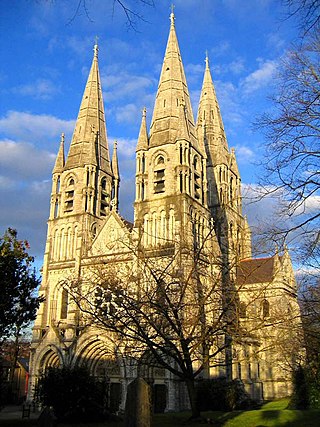
The Diocese of Cork, Cloyne and Ross, also referred to as the United Diocese of Cork, Cloyne and Ross, is a diocese in the Church of Ireland. The diocese is in the ecclesiastical province of Dublin. It is the see of the Bishop of Cork, Cloyne and Ross, the result of a combination of the bishoprics of Cork and Cloyne and Ross in 1583, the separation of Cork and Ross and Cloyne in 1660, and the re-combination of Cork and Ross and Cloyne in 1835.
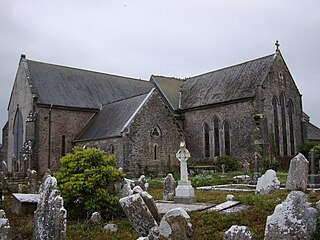
St. Colman's Cathedral, Cloyne is a cathedral of the Church of Ireland in Cloyne, County Cork in Ireland. It is in the ecclesiastical province of Dublin. Originally a Roman Catholic cathedral, it was converted to an Anglican cathedral in 1678.

St. Begnet, also Begneta, Begnete, Begnait or Becnait is a patron saint of Dalkey, Ireland. She is noted as a "virgin, not a martyr." Her feast day is November 12. Two ruined churches in Dalkey are named for Begnet, one on Dalkey Island, and the other near the 14th-century stone townhouse now serving as Dalkey Castle and Heritage Centre, in the area known as Kilbegnet. A holy well located near the martello tower on the island is also associated with her; as the Irish playwright Hugh Leonard observed:
A few yards away are the ruins of a church supposedly built by the town's patron saint, St. Begnet. Like St. Patrick himself, St. Begnet may never have existed: There is even uncertainty as to whether he or she was male or female. No one bothers to argue about this: In Dalkey, when it is a question of sainthood, sex is hardly likely to have much relevance.
Bé Binn iníon Urchadha was a Princess of the Uí Briúin Seóla and Queen of Thomond.

Killiney Hill is the southernmost of the two hills which form the southern boundary of Dublin Bay, the other being Dalkey Hill. These two hills form part of Killiney Hill Park.
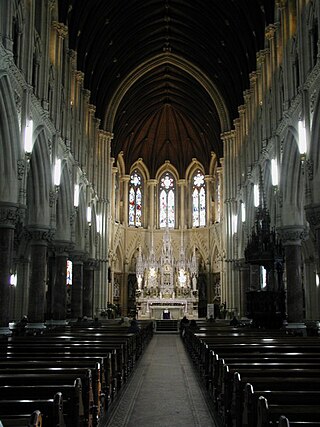
The Diocese of Cloyne is a Latin diocese of the Catholic Church in Ireland. It is one of six suffragan dioceses in the ecclesiastical province of Cashel.
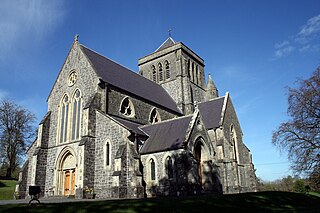
St Fethlimidh's Cathedral, Kilmore is one of two cathedral churches in the Diocese of Kilmore, Elphin and Ardagh in the Church of Ireland. It is situated in the parish of Kilmore, southwest of the county town of Cavan. The name Kilmore - Cill Mhor meaning 'the great church' - reflects an earlier prominence that the Annals of the Four Masters have traced to an early medieval foundation. Of that church there are no physical remains

Tully Church is an ancient church in County Dublin, Ireland.

Kill of the Grange, often Kill o' the Grange, is a suburban community and ancient parish in the half-barony of Rathdown, within the traditional County Dublin, in the jurisdiction of Dún Laoghaire–Rathdown. It contains an early religious site, which is a National Monument. The area, sometimees described as a twin of, and sometimes as part of, Deansgrange, is 5 miles southeast of Dublin.

Kilcroney Church is a medieval church and National Monument in County Wicklow, Ireland.




















